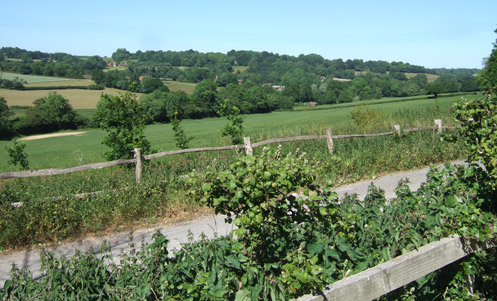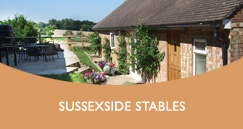ENTOMOLOGY – As an angling instructor and fishery consultant I take a particular interest in the natural fly life and pond life in and around the lakes. April to June is the best time of the year for this and on my guided walks I do a pond dipping session using a small portable aquarium made for the purpose, so that you can get up close to study and learn about some of the fascinating creatures that dwell in the lakes. We have an abundance of pond skaters, water boatmen, freshwater snails, caddis, dragon and damsel flies, olives and a prolific hatch of the quintessential anglers fly the Mayfly - the dance of the Mayfly Spinner is something very magical.
MAMMALS – On your walks around the farm and lakes you are quite likely to see wild Deer, especially at first light. Generally they are Fallow Deer but occasional Roe are spotted particularly in the woodland over towards Tolhurst Farm. (If you want see more Deer then a trip to Ashdown Forest is a must) You can also see Rabbits, occasionally a Water Vole - though their arch enemy the Mink are also sadly found on the Kent Water so the vole numbers have dropped in recent years.
We also have Foxes and Badgers and the occasional Brown Hare in the valley. Oh and one report from a neighbour the year before last even suggested he’d seen some Wild Boar down by my lakes. Not impossible as they were reintroduced in Sussex a while back and they are nocturnal, but I think he had just returned from a late night party so I am just a little sceptical about this sighting!
BIRDS – I am very keen on the wild birds in these parts and there are feeders to encourage the smaller birds to stay.
On my feeders you should see many of the smaller British birds such as Tits – Coal, Great, long tailed and Blue, Sparrows, Dunnock, Robins, Chaffinch, Bullfinch, Greenfinch, Pied Wagtail, Wrens, Nuthatch. Bigger visitors to the feeder are the Greater and Lesser spotted Woodpecker – we have Green Woodpeckers around too but they don’t seem to like the feeders – Magpie and rooks also visit but they are not so welcome!
Around the buildings and adjacent trees look out for our Tree Creeper, Pied Wagtail, Grey Wagtail (with the yellow tummy) the true Yellow Wagtail and the little Jenny Wren.
Down at the lakes you should see one of several pairs of Kingfishers, Herons, Duck – Mallard and our Carolina Wood Ducks that visit us every year, the occasional Teal, and Tufted Duck, Coots, Moorhens, Reed Warbler and of course the ubiquitous White Swans as well as Canada or Greylag Geese. I was even lucky enough just a few years back to be visited for a few days by the extremely rare Bittern - probably stopping for a rest on its migration from the Norfolk Broads to the continent.
Out on the fields and hedgerows look out for Pheasants and Partridges (though sadly I haven’t seen a Grey Partridge here for a number of years only the French Red-Legged Partridge) Fieldfare, Song Thrush, Mistle Thrush and Blackbirds, Redwing, Lapwing, Skylark, Swifts, Swallows and Martins –particularly in the Mayfly season
If Birds of prey are your thing, we have a resident Barn Owl – how fantastic to watch it quartering on a summers evening at dusk out on our fields - Little Owls, Buzzards, Kestrel, Sparrow Hawk, Cuckoo and the occasional Osprey passes over the farm travelling between the bigger waters such as Weir Wood and Bewl.
Don’t forget finally if you really are a died-in-the-wool, dedicated twitcher, take time out locally to visit the Ashdown Forest to try to catch a glimpse of the now endangered Dartford Warbler and Nightjar and then pop over to Weir Wood in Forest Row (15 minutes from us at Kent Border Cottages) to see one of the best SSSI Bird sanctuaries in these parts www.weirwood.me.uk
WILDLIFE & FLOWERS - A Year at Little Saxbys farm
Though there is always something special about a cold winter’s day and the glow of a lovely log burning stove, by mid-February I am usually searching for the signs that warmer weather is on the way.
For many years I have kept a record of such things like the first frog spawn (a good indicator that it is time to plant my potatoes!) the return of our Carolina Wood Ducks and the Swallows from Africa, the first snow drops, the first hatch of Mayfly on the lakes etc. Interestingly the timings of each vary very little, a matter of a few days only, despite the weather. I think it has more to do with the light hours.
This year 2015, I am going to post some of the hopefully interesting ones on here.
28th January – the first of our Snow Drops came into flower. These lovely wild flowers abound around my lakes and along the river banks and brave the coldest weather to give the first sign of life to the year.

20th February – The first of our daffodils – not strictly a wild flower I know but a welcome first flash of colour to herald spring. We have a few Crocuses too but most of these get eaten by slugs!

28th February – The first wild primrose broke bud and bloomed. We seem to have quite a few of truly wild primroses (not the cultivated Primula found in your Garden Centre) in this area as well as their close relation the cowslips.

April & May -
The very best of our wild flowers in the Kent Sussex Weald really start to bloom from the equinox (equal night and daylight hours) on March 21st.






